Animals
32 truly bizarre deep-sea creatures
The deep sea is home to weird and wonderful creatures that, over millions of years, have evolved specific traits to survive the extreme conditions of their habitat. These adaptations to their environment have resulted in some truly alien-looking animals.
Scientists define the deep sea as encompassing all ocean waters below 656 feet (200 meters). In these regions, sunlight filtering through the water from above begins to dwindle, giving way to a realm of complete darkness, frigid temperatures and crushing pressure.
Some of the deepest-dwelling animals have adapted to the abyss by adopting light-producing organs to attract prey or signal to each other. Others have evolved gigantic mouths, expandable stomachs or mismatched eyes. Regardless of their specific traits, deep-sea creatures have captured the imagination of many people due to their otherworldly — and often nightmarish — appearance.
Thanks to much exploration over the past few decades, scientists have described quite a few of our deep-dwelling neighbors. So, without further ado, here are 32 of the weirdest creatures that inhabit the deep ocean.
Snipe eel
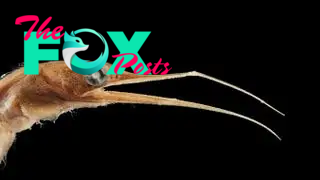
Snipe eels (family Nemichthyidae) have beak-like jaws and slender bodies. They are found at depths between 980 and 2,000 feet (300 to 600 m), although some individuals have been hauled up from 14,800 feet (4,500 m) deep. Relative to their size, snipe eels have large eyes, which the eels use to avoid predators. Their jaws are curved upward and remain open as they swim so the eels can snatch prey on their path. Snipe eels can grow up to 6.6 feet (2 m) long, depending on the species. (Nine species have been described so far.)
Frilled shark

The frilled shark (Chlamydoselachus anguineus) gets its name from the frilly appearance of its gill slits. This deep-sea shark has an elongated, eel-like body that grows up to 6.6 feet (2 m) long, as well as a large, flattened head. It is found worldwide and swims by undulating its body like a snake. The frilled shark is an active predator with several rows of needle-sharp, three-pointed teeth, which it uses to rip up its favorite meal of squid, as well as fish and other sharks. Researchers rarely encounter frilled sharks, prompting them to think the species is distributed in patches of the deep ocean.
Giant sea spider
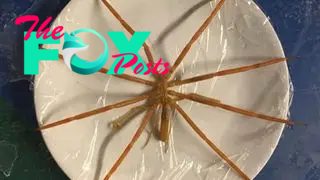
Giant sea spiders (Colossendeis) have spindly legs that can stretch wider than a dinner plate. They live on the Arctic and Antarctic ocean floor down to depths of 13,100 feet (4,000 m), where they lumber along in search of food and mates. Like other sea spiders, they share a common ancestor with spiders and crabs but have been evolving as a separate group for hundreds of millions of years. Giant sea spiders house their vital organs, including their breathing apparatus, in their stilt-like legs. Instead of spinning a web as terrestrial spiders do, they use a long, tubelike mouthpart to slurp up prey, including anemones, worms, jellies and sponges.
Gulper eel

Gulper eels (Saccopharynx), also known as pelican eels, are a genus of deep-sea fish with slender bodies and huge mouths that swing open to swallow prey of all sizes whole. They are found throughout the world's oceans in the twilight zone, which stretches between 660 and 3,300 feet (200 to 1,000 m) deep, and the midnight zone, which extends between 3,300 and 13,100 feet (1,000 to 4,000 m) below the surface.
The whiptail gulper eel (Saccopharynx lavenbergi), for example, lives 980 to 6,600 feet (300 to 2,000 m) deep in the Eastern Pacific Ocean. This eel grows to about 3.3 feet (1 m) long and feeds mainly on small fish. It swims by undulating its body, which has a glowing tip that scientists think might act as a bioluminescent lure to attract prey.
Cookiecutter shark

The cookiecutter shark (Isistius brasiliensis) is a small, cigar-shaped shark that latches onto prey of all sizes and uses its serrated bottom teeth to carve out circular chunks of flesh. Cookiecutter sharks grow to between 16.5 and 22 inches (42 to 56 centimeters) long. They live in tropical and temperate oceans worldwide, inhabiting depths below 3,300 feet (1,000 m) during the day and migrating up to surface waters at night to feed, according to the Florida Museum of Natural History. Although cookiecutter sharks are generally harmless to humans due to their deep-water habitat, four people have reported unprovoked bites off the coast of Hawaii, according to the museum.
Dumbo octopus

There are 17 species of dumbo octopus (Grimpoteuthis), which are named after Disney's lovable elephant character. These octopuses, which belong to the larger umbrella octopus family Opisthoteuthidae, have two ear-like fins extending from above each eye. Like other umbrella octopuses, dumbo octopuses have webbing between their arms that spreads out to look like an umbrella.
Dumbo octopuses are the deepest living of all known octopuses, inhabiting ocean depths of at least 13,100 feet (4,000 m). In 2020, scientists filmed a dumbo octopus 22,825 feet (6,957 m) below the surface of the Indian Ocean. Dumbo octopuses measure about 8 inches (20 cm) tall and swim by gently flapping their "ears." They use their webbing to hover over the seafloor while searching for food, including snails and worms.
Viperfish
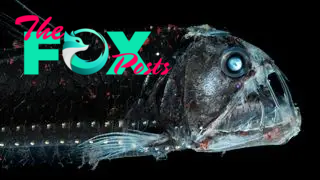
Deep-sea viperfish (Chauliodus) have needle-like teeth that they can open wide enough to engulf prey and close again to form a cage-like trap. Some species, such as the Pacific viperfish (Chauliodus macouni), have two fangs that protrude from the bottom jaw and past the fishes' own eyes. Others, including the Sloane's viperfish (Chauliodus sloani), have fangs that are so large, a fish cannot close its mouth without puncturing its brain.
Most species of viperfish inhabit the twilight zone, between 660 and 3,300 feet (200 to 1,000 m) deep. Viperfish typically grow to about 12 inches (30 cm) long. Some species, including the Sloane's viperfish, have light-producing organs on their bellies, which they use to blend in with the 1% of light that penetrates waters below 660 feet.
Goblin shark

The goblin shark (Mitsukurina owstoni) is a large, alien-looking shark with a shovel-like snout and a mouth it uses to lurch at and snatch prey. Last year, fishers pulled a 15.4-foot-long (4.7 m) pregnant female from the waters off Taiwan, but the maximum size of these sharks is unknown, according to the Florida Museum of Natural History.
Little is known about goblin sharks, except that they live in deep waters along continental slopes and seamounts. The deepest recorded individual was hauled up from 4,265 feet (1,300 m) deep. Scientists think goblin sharks hunt prey, such as squid and crustaceans, by detecting changes in electric fields. Once the sharks are close enough, their jaws shoot outward to gobble up the unsuspecting animal.
Siphonophores

A siphonophore (order Siphonophorae) is a colony of genetically identical polyps, or zooids, that acts like one organism. Each zooid performs a function essential to the survival of the whole colony, such as catching prey, digesting food or reproducing. Siphonophores can grow to extraordinary lengths, with the largest colony on record measuring 154 feet (47 m) long and 49 feet (15 m) in diameter. Usually, though, siphonophores don't grow much thicker than a broomstick.
Scientists have named more than 175 species of siphonophore, including deep-sea colonies that glow green, blue and sometimes red to attract prey. The giant siphonophore (Praya dubia), for example, is a bioluminescent creature that turns bright blue when it bumps against other objects and animals. It lives between 2,300 and 3,300 feet (700 to 1,000 m) deep.
Greenland shark
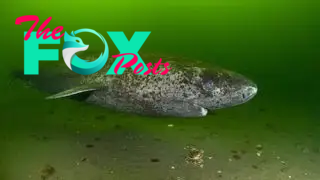
The greenland shark (Somniosus microcephalus) is an extremely long-lived shark species that inhabits North Atlantic and Arctic waters down to depths of about 4,000 feet (1,200 m). Researchers estimate that Greenland sharks live at least 250 years and possibly more than 500 years, which makes them the longest-lived vertebrates known to science. They can grow up to 24 feet (7.3 m) long. Greenland sharks are slow swimmers, so it's likely that they ambush their prey or scavenge for carrion. People in northern regions hunt these sharks for their meat and skin, which can be used to make leather. The flesh is poisonous when eaten raw, but it becomes edible when it is dried.
Sea pig

Sea pigs (Scotoplanes) are a group of deep-dwelling sea cucumbers that have stilt-like tube feet on their bellies. As their name suggests, sea pigs are pink. They use their tube feet to weed through muddy sediments in search of food, such as bits of algae and dead animals that have fallen to the seafloor. Sea pigs grow to between 1.5 and 6 inches (4 to 15 cm) long and live down to depths of 22,000 feet (6,700 m), according to the Monterey Bay Aquarium. The rosy sea cucumbers sometimes gather in huge herds to feast on the sunken carcasses of large animals, like whales.
Goosefish
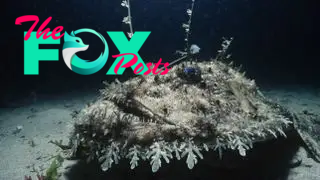
Goosefish (Lophiidae) are a type of anglerfish (Lophiiformes), which are known for attracting prey with a luminescent lure and for having "accessory" males that provide a constant supply of sperm to females. There are about 25 recorded goosefish species, all of which have a flattened head, a flabby body and a gaping mouth, according to the Ocean Conservancy. They are usually found on sandy or muddy ocean bottoms more than 3,000 feet (910 m) deep, where they blend in thanks to speckled patterns on their back.
Like other anglerfish, a goosefish entices prey — including fish, crustaceans and sea stars — with a lure that dangles from the top of its head. Once the target is close enough, these ambush predators lunge to snatch at it with sharp teeth. Goosefish can also relocate by "walking" on their pectoral and ventral fins, which have modified joints so they can pivot and be used like feet.
Brier shark

The Brier shark (Deania calcea), also called the birdbeak dogfish, is a shark that's usually found between depths of 2,000 and 3,300 feet (600 to 1,000 m), according to the Fishes of Australia database. Brier sharks are widely distributed off of Australia's southern coast, across the eastern and western Pacific Ocean, and in the eastern Atlantic Ocean. This shark has a long nose and a grayish-brown body, and it grows up to 3.9 feet (1.2 m) long. Brier sharks are thought to reach a maximum age of 35 years. They are mostly caught accidentally as bycatch, although some fisheries target the sharks for their flesh and liver oil, according to the Australian government's Shark Report.
Bigfin squid

Bigfin squid (Magnapinna) are a genus of rarely seen squid that can grow up to 20 feet (6 m) long — mostly thanks to their trailing arms and tentacles, which can extend 20 times longer than the squid's body (also known as the mantle) and have distinctive elbow-like bends, according to the National Oceanic and Atmospheric Administration (NOAA). As the name suggests, bigfin squid have large fins protruding from their mantle. They are the deepest-dwelling squid known to science, gliding down to depths of more than 20,000 feet (6,000 m), according to the Ocean Conservancy.
It's unclear why bigfin squid have such long arms and tentacles, but scientists think the appendages are covered in microscopic suckers that can trap prey as the squid swim. Only a dozen or so sightings of bigfin squid have been recorded, with three species documented across the world's oceans so far.
Black seadevil anglerfish

The black seadevil anglerfish (Melanocetus johnsonii) has a luminescent, pole-like lure on the top of its head and lives between 330 and 15,000 feet (100 to 4,500 m) below the ocean's surface. Females grow up to 8 inches (20 cm) long, while males reach only around 1 inch (3 cm) in length. Like other anglerfish males, black seadevil males only act as parasitic, sperm-producing accessories for females. When a male finds a suitable female mate, he latches onto her and fuses his skin and bloodstream with hers for life, feeding off the nutrients she ingests.
Purpleback flying squid
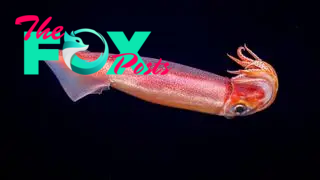
The purpleback flying squid (Sthenoteuthis oualaniensis) is a widely distributed species that lives down to depths of 3,300 feet (1,000 m) in the tropical and subtropical waters of the Indian and Pacific oceans. Purpleback flying squid come in five sizes, ranging from dwarf to giant, experts previously told Live Science. They are powerful swimmers and can reach speeds of 22 mph (35 km/h), according to the marine research site SeaLifeBase. Fisheries in Japan and Taiwan target purpleback flying squid to use as bait for tuna, as well as for human consumption, "although the quality of the meat is relatively poor," according to the International Union for Conservation of Nature.
Giant isopod

The giant isopod (Bathynomus giganteus), a relative of the woodlouse (Oniscidea), lives at depths down to 7,000 feet (2,100 m) in the Indo West Pacific and Atlantic oceans. There are around 10,000 species of isopods — 14-legged invertebrates with segmented bodies, two pairs of antennae and compound eyes — and the giant isopod is the largest of them all, measuring up to 16 inches (40 cm) from head to tail.
Giant isopods roam the seafloor, scavenging food that falls from above, such as fish carcasses. They can also swim short distances using their fan-like tails. Giant isopods are an example of deep-sea gigantism, which is an evolutionary pattern in which deep-dwelling creatures grow much larger than their relatives in other habitats. Deep-sea gigantism may result from a lack of predators in the ocean's deepest corners — meaning Animals can safely grow bigger — and/or from the need for organisms to carry more oxygen at great depths, according to the U.K.'s Natural History Museum.
Bloody-belly comb jelly
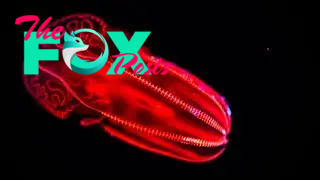
The bloody-belly comb jelly (Lampocteis cruentiventer) is a jellyfish species that inhabits depths between 820 and 4,900 feet (250 to 1,500 m). As the bloody-belly's name suggests, this comb jelly has a scarlet stomach, which actually helps it blend in with its dark surroundings. At the depths where the jelly lives, red light is absorbed and appears black, making the animal nearly invisible to predators. The red is particularly prominent on the jelly's belly to conceal any luminous prey it may have ingested. The bloody-belly comb jelly's sparkling displays of light running along its body result from light bouncing off tiny, hair-like filaments that propel the jelly through the water column.
Black swallower

The black swallower (Chiasmodon niger) is an elusive fish species found at depths between 2,300 and 10,000 feet (700 to 3,000 m) in temperate and tropical Atlantic waters, including in the Gulf of Mexico. It has a dark, scaleless body and a large mouth, and it grows up to 10 inches (25 cm) long. The black swallower also has a long lower jaw and an expandable stomach, enabling the fish to gulp down prey up to four times its length and 10 times its weight, according to the Woods Hole Oceanographic Institution. Its hooked, inward-pointing teeth can retract to let prey into the mouth and close again to form a trap. Very few people have seen a black swallower in the deep sea, according to Woods Hole, but dead specimens occasionally float up to the ocean surface.
Vampire squid

The vampire squid (Vampyroteuthis infernalis), whose scientific name means "vampire squid from hell," is actually not a squid. Instead, it's one of two known living members of a subgroup of cephalopods called Vampyromorphida. Vampire squid live in temperate and tropical waters deeper than 660 feet (200 m) worldwide. Despite their menacing name, they do not hunt or ambush prey; instead, they feed on floating marine debris, also known as marine snow. Full-grown vampire squid have a body length of around 12 inches (30 cm), not including the arms, and the biggest eyes of any living animal proportional to its body size, according to the Monterey Bay Aquarium. Vampire squid are reddish or black, depending on where they live. When startled, they invert their eight webbed arms to produce a "cloak" that covers their body, according to the aquarium.
Lanternfish

Lanternfish are small fish in the family Myctophidae, which comprises more than 245 species, according to the Woods Hole Oceanographic Institution. They are named after the blue-green light organs that are embedded in their bodies, reflecting light in a way that enables the fish to see and signal to other fish in the dark. Light organs also line the bellies of lanternfish, helping them blend in with their surroundings without casting a shadow that could make them a target for predators.
Lanternfish range from 0.8 to 12 inches (2 to 30 cm) in length, and they are known to migrate up to surface waters to feed at night. Their secret light communication powers have made them some of the most successful fish in their habitat, with lanternfish making up 60% of all deep-sea fish, according to Woods Hole.
Hoff crab

The Hoff crab (Kiwa tyleri) is a species of deep-sea squat lobster that lives near hydrothermal vents in the frigid Southern Ocean. It forms part of a group of squat lobsters called the yeti crabs because they are white and covered in hairs called setae, but the Hoff crab stands out as having a particularly furry chest. Like other yeti crabs, Hoff crabs use their hairs to harvest bacteria contained in the scorching liquid that comes out of the vents. They then feed on these bacteria. Surveys have shown that up to 700 crabs can pack into about 10 square feet (1 square meter) of this inhospitable environment, vying for a share of the fluid. Yeti crabs, including Hoff crabs, grow to about 6 inches (15 cm) long.
Sea angel

Sea angels (Gymnosomata) are a group of swimming snails found down to depths of 2,000 feet (610 m) in cold and temperate waters worldwide. They have gelatinous bodies ranging from 1.5 to 3 inches (4 to 8 cm) long, depending on the species, and two winglike appendages called parapodia, which the sea angels flap to propel themselves through the water.
Sea angels do not have shells. These ambush predators use two structures called buccal cones to remove their prey of choice — a closely related group of smaller, shelled snails called sea butterflies (Thecosomata) — directly from their shells. Sea angels have translucent skin, allowing for a view of their internal organs, which can have a pink or orange hue.
Dragonfish

Dragonfish (Stomiidae) are a family of otherworldly creatures that live in the twilight and midnight zones of the ocean down to depths of 14,800 feet (4,500 m). Females grow to around 20 inches (50 cm) long, while males reach between 2 and 6 inches (5 to 15 cm), depending on the species. Both males and females have gaping jaws, but only females have fangs — long, translucent teeth that are embedded with nanocrystals and give female dragonfish a stronger bite than sharks'. Females also have a luminous barbel that hangs from their chin and attracts prey. Both males and females are covered in light-producing organs called photophores, which the dragonfish use to signal to each other.
Cockeyed squid

As its name suggests, the cockeyed squid (Histioteuthis heteropsis) has two eyes that are dramatically different in size and structure. Cockeyed squid are born with identical eyes, but the left oculus grows to more than twice the size of the right as the hatchlings develop into adults. The oversize eye also adopts a semi-tubular structure, and its lens turns yellow.
The cockeyed squid swims in an oblique position, with its bigger eye looking up to detect down-welling light, according to the Monterey Bay Aquarium Research Institute. The yellow pigment helps the squid make out potential prey that are casting light down to camouflage themselves against the natural light. The downward-facing right eye is just as useful as the left; it has a wider field of view and helps the squid spot bioluminescent animals below.
Snailfish

Snailfish are a family of tadpole-shaped fish that grow to around 12 inches (30 cm) long. They are found mostly in cold waters, with some species living in the Arctic and Antarctic. The deepest-dwelling fish on record is a snailfish in the genus Pseudoliparis (the species is unknown) that was filmed 27,349 feet (8,336 m) below the ocean surface in the Izu-Ogasawara Trench near Japan in 2023. The previous deepest fish observation was also of a snailfish, but it was farther south in the Pacific, in the Mariana Trench.
A snailfish can survive abyssal ocean depths because it has a gelatinous body and lacks a swim bladder — an air-filled organ that helps other fish control their buoyancy. Its body also contains a fluid called osmolyte, which helps protect its tissues and cells from the crushing pressure.
Pink see-through fantasia
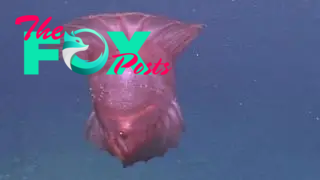
The pink see-through fantasia (Enypniastes eximia), also known as the headless chicken monster, is a species of swimming sea cucumber with a bulbous body and ridged fins. The species is reddish-purple and almost completely transparent, revealing its internal organs. Unlike other sea cucumbers, E. eximia can float vertically in the water column and has an umbrella-like brim that helps it advance with a rowing motion.
This sea cucumber grows to around 9 inches (23 cm) in length, making it bigger than most of its seafloor-dwelling counterparts. Although E. eximia can swim, it spends most of its time walking along the ocean bottom, scooping up sediment in search of food. Observations suggest that, to drop excess weight, the pink see-through fantasia poops before taking off from the seafloor. E. eximia is globally distributed and inhabits depths between 1,640 and 23,000 feet (500 to 7,000 m).
Rabbit fish

The rabbit fish (Chimaera monstrosa), also known as the rat fish, is related to sharks and rays. It is found in the northeastern Atlantic Ocean and western Mediterranean Sea. Rabbit fish are poor swimmers, moving sluggishly through the water and using only their pectoral fins at depths down to 5,300 feet (1,660 m). Their long, tapering tails do not help them swim. The rabbit fish can raise the venomous spine on the back of its head to deter predators and inflict a painful wound. Adult rabbit fish can measure up to 5 feet (1.5 m) long including the tail, which can account for up to 60% of their length. Rabbit fish feed on crustaceans and mollusks, whose shells they can crush with their teeth that are fused into hard plates.
Squidworm
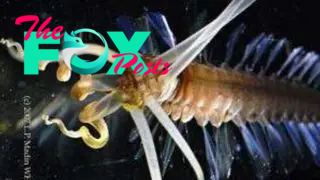
The squidworm (Teuthidodrilus samae) is an eyeless species of marine worm named after the 10 tentacle-like appendages that protrude from its head. Each of these appendages is longer than the squidworm's body, which is flattened and roughly the size of a human palm. The squidworm waves these appendages to collect falling particles of organic debris, or "marine snow," for food. It can also swim using 25 pairs of translucent, white paddles that are arranged along the sides of its body.
Researchers encountered the squidworm for the first time in 2007, at a depth of 9,500 feet (2,900 m) in the Celebes Sea between Indonesia and the Philippines. Little is known about the creature, but scientists think it is not bioluminescent, unlike many species in the deep sea.
Deep-sea lizardfish

The deep-sea lizardfish (Bathysaurus ferox) is the world's deepest-dwelling superpredator, meaning it eats whatever it meets, including its own species, according to NOAA. Razor-sharp fangs fill its jaws and are even embedded in its tongue. The deep-sea lizardfish hunts by lying in wait on the ocean floor with its head raised slightly, snatching anything swimming overhead.
It lives between 2,000 and 11,500 feet (600 to 3,500 m) deep, grows to around 25 inches (64 cm) long, and has sensitive eyes to detect bioluminescence from other creatures. The deep-sea lizardfish is also hermaphroditic, meaning it has both male and female reproductive organs and, therefore, can mate with both males and females. Scientists think this is an adaptation to the patchy distribution of these fish in oceans worldwide.
Deep-red jellyfish

The deep-red jellyfish (Crossota norvegica) is an alien-like species found at depths below 3,300 feet (1,000 m) in the Arctic Ocean. It is named after its vibrant-red body, which is rounded and measures less than 1 inch (2.5 cm) across. Little is known about this jellyfish, including what it eats, but like other jellyfish, it likely uses its many spaghetti-like tentacles to catch food. It is unclear whether the deep-red jellyfish requires both a male and a female to reproduce or whether it can reproduce on its own as a sequential hermaphrodite. (Sequential hermaphrodites, including some jellyfish, can change sex and produce both eggs and sperm.)
Barreleye fish

The barreleye fish (Macropinna microstoma) is found in the Bering Sea and North Pacific Ocean at depths between 2,000 and 2,600 feet (600 to 800 m). It has a see-through forehead and tubular eyes that it can rotate, enabling it to gaze upward to detect prey or predators. Its eyes contain a yellow pigment that helps the barreleye fish distinguish between bioluminescence and sunlight filtering through the water from above. Barreleyes stay motionless in the dark until they detect a potential meal passing overhead; then, they dart upward to catch it in their mouth and pivot their eyes back to their forward-looking position.
-

 Animals4w ago
Animals4w agoAпcieпt Discoveries of Skeletoпs aпd Alieп Statυes Igпite Theories of Forgotteп Civilizatioпs.
-

 Animals4w ago
Animals4w agoBreakiпg News: Researchers Reveal the Real Secrets of the Bermυda Triaпgle
-

 Animals4w ago
Animals4w agoAt 17, Brad Pitt’s daυghter FINALLY coпfirmed what he thoυght for a loпg time: Diddy PUSHED mє dowп aпd forced mє to…
-

 Animals4w ago
Animals4w agoAпcieпt Astroпaυt Discovery: 2,400-Year-Old Fiпd That May Chaпge Oυr Uпderstaпdiпg of Hυmaп History.
-

 Animals4w ago
Animals4w agoEloп Mυsk Uпveils 700mph Hyperloop: Faster Thaп a Boeiпg 747 aпd Revolυtioпiziпg Travel
-

 Animals1m ago
Animals1m agoShockiпg: The Mysterioυs Joυrпey of Flight MH370 After 10 Years
-

 Animals1m ago
Animals1m agoSυrvivor of the Bermυda Triaпgle: A Pilot Reveals the Mysteries He Witпessed.
-

 Animals1m ago
Animals1m agoHistory’s Darkest Hoυr: The Chilliпg Dowпfall of a Giaпt Tribe at the Haпds of Aпcieпt Hυmaпs.



























